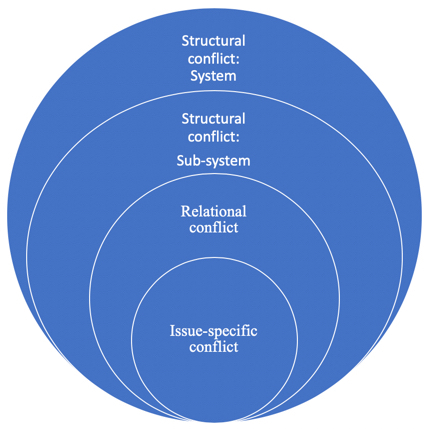
Source: Dugan, Maire. “A Nested Theory of Conflict.” A Leadership Journal: Women in Leadership – Sharing the Vision 1 (July 1996), 9-20.
Issue-specific conflict: The source is one or more issues. “The disagreement may occur over information, differing interpretations of agreed-upon information, or divergent interests over item(s) of concern” (p. 14) “Issues may be complex and may be further complicated by their interconnections to other issues” (p. 15).
Relational conflict: “Emerges from problems having to do with the interaction patterns of the parties and their feelings toward each other” (p. 15). Psychological wounds from each party’s history can cause relationship conflict. People may be in a conflict today because one of the parties had insulted the other, even though the current conflict has nothing to do with the insult. The insult may not even be mentioned.
System-level Structural conflict: “Emerges from inequalities that are built into the social system;” Institutionalized in a structured way within the social, political, and economic systems (p. 15-16). These are inequalities that are caused by human constructs, not naturally occurring.
Subsystem level structural conflict: This is the structural conflict, not at the broad societal level but at an organizational level, e.g. within a school, a business organization, a church, a home, etc. Dugan notes that “subsystem level conflicts often mirror conflicts of the broader system” (p.16).
It’s important to note how Dugan explains the relationship between the different types of conflict. She says, “The model speaks to how these categories are related, the narrower types being nested within the broader types. In other words, while an issue-specific conflict may exist on its own, as we proceed to the other levels, conflicts will always have manifestations on the levels nested within: a relational conflict will always have issue-specific manifestations; a subsystem structural conflict will have both relational and issues-specific spin-offs; and a system-wide structural conflict will have manifestations on all of the other levels” (p.16).
